A)
B)
C)
D)
Correct Answer

verified
A
Correct Answer
verified
Multiple Choice
Choose the one alternative that best completes the statement or answers the question. Solve the problem. -
A) Shift the graph of down 17 units.
B) Shift the graph of up 17 units.
C) Shift the graph of right 17 units.
D) Shift the graph of left 17 units.
Correct Answer

verified
Correct Answer
verified
True/False
Determine whether the graph is the graph of a function.
-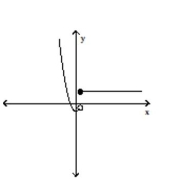
Correct Answer

verified
Correct Answer
verified
Multiple Choice
Perform the requested operation or operations. Find the domain of each. - Find .
A) ; domain:
B) ; domain:
C) ; domain:
D) ; domain:
Correct Answer

verified
Correct Answer
verified
Multiple Choice
Find two functions defined implicitly by the given relation. -
A) or
B) or
C) or
D) or
Correct Answer

verified
Correct Answer
verified
Multiple Choice
Perform the requested operation or operations. - Find .
A)
B)
C)
D)
Correct Answer

verified
Correct Answer
verified
Multiple Choice
Match the numerical model to the corresponding model. -
A) ![]()
B) ![]()
C) ![]()
D) ![]()
Correct Answer

verified
Correct Answer
verified
Multiple Choice
Find the asymptote(s) of the given function. - vertical asymptotes(s)
A)
B)
C)
D)
Correct Answer

verified
C
Correct Answer
verified
Multiple Choice
Sketch the graph of y1 as a solid line or curve. Then sketch the graph of y2 as a dashed line or curve by one or more of
these: a vertical and/or horizontal shift of the graph y1, a vertical stretch or shrink of the graph of y1, or a reflection of the
graph of y1 across an axis.
-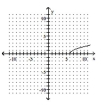
A)
B)
C)
D)
Correct Answer

verified
Correct Answer
verified
Multiple Choice
Choose the one alternative that best completes the statement or answers the question.
-For the graph shown, at which point does the function change from increasing to decreasing?
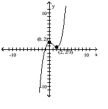
A)
B)
C)
D)
Correct Answer

verified
Correct Answer
verified
Multiple Choice
Tell which of the following types of regression is likely to give the most accurate model for the scatter plot shown: linear
regression, quadratic regression, cubic regression, exponential regression, sinusoidal regression.
-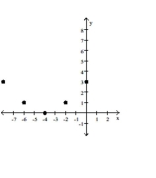
A) Linear regression
B) Quadratic regression
C) Cubic regression
D) Sinusoidal regression
E) Exponential regression
Correct Answer

verified
Correct Answer
verified
Multiple Choice
Fill in the blanks to complete the statement.
-The graph of can be obtained from the graph of by reflecting across the  -axis, shrinking vertically by a factor of 11ecc462_eee5_8183_841e_b1b874fd7cdc_TB8181_00 and then shifting vertically11ecc462_eee5_8183_841e_b1b874fd7cdc_TB8181_00 units in the ? direction 11ecc462_eee5_8183_841e_b1b874fd7cdc_TB8181_00 .
-axis, shrinking vertically by a factor of 11ecc462_eee5_8183_841e_b1b874fd7cdc_TB8181_00 and then shifting vertically11ecc462_eee5_8183_841e_b1b874fd7cdc_TB8181_00 units in the ? direction 11ecc462_eee5_8183_841e_b1b874fd7cdc_TB8181_00 .
A) ; downward
B) ; upward
C) ; downward
D) ; downward
Correct Answer

verified
Correct Answer
verified
Multiple Choice
Perform the requested operation or operations. Find the domain of each. - Find .
A) domain
B) domain
C) ; domain
D) domain
Correct Answer

verified
Correct Answer
verified
Multiple Choice
Solve the equation algebraically. -
A)
B)
C)
D)
Correct Answer

verified
Correct Answer
verified
Multiple Choice
Graph the function and determine if it has a point of discontinuity at x = 0. If there is a discontinuity, tell whether it is
removable or non-removable.
-
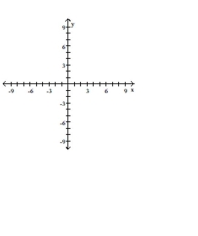
A) ![]()
No
B) ![]()
No
C) ![]()
Yes; removable
D) ![]()
No
Correct Answer

verified
C
Correct Answer
verified
Multiple Choice
Find the asymptote(s) of the given function. - vertical asymptotes(s)
A) None
B)
C)
D)
Correct Answer

verified
Correct Answer
verified
Multiple Choice
Perform the requested operation or operations. - Find .
A)
B)
C)
D)
Correct Answer

verified
Correct Answer
verified
Multiple Choice
Graph the function and determine if it has a point of discontinuity at x = 0. If there is a discontinuity, tell whether it is
removable or non-removable.
-
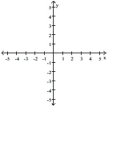
A) ![]()
Yes; removable
B) ![]()
No
C) ![]()
No
D) ![]()
Yes; non-removable
Correct Answer

verified
Correct Answer
verified
Multiple Choice
Find the asymptote(s) of the given function. - vertical asymptotes(s)
A)
B)
C)
D)
Correct Answer

verified
Correct Answer
verified
Multiple Choice
Identify which of the twelve basic functions listed below fit the description given. -The one function that is decreasing from
A)
B)
C)
D)
Correct Answer

verified
Correct Answer
verified
Showing 1 - 20 of 362
Related Exams